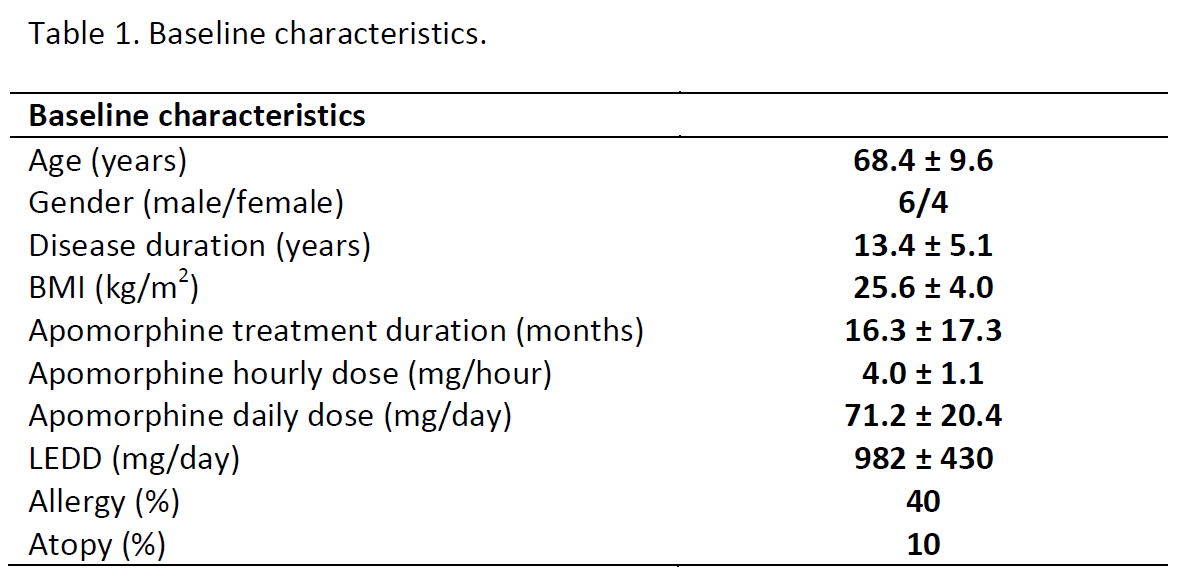Session Information
Date: Monday, September 23, 2019
Session Title: Neuropharmacology
Session Time: 1:45pm-3:15pm
Location: Les Muses Terrace, Level 3
Objective: To evaluate the efficacy of 4 treatment modalities on apomorphine-induced subcutaneous nodules as compared to no treatment.
Background: Subcutaneous nodules are the most common adverse events of continuous subcutaneous apomorphine infusion. However, the pathogenesis and histopathology of subcutaneous nodules are poorly understood and therefore the current treatment modalities for subcutaneous nodules lack proper evidence.
Method: The efficacy of 4 treatment modalities, including massage with a spikey ball, topical application of hydrocortisone 1%, dilution of apomorphine from 0.5% to 0.25%, and the injection of subcutaneous hydrocortisone 10mg, were compared to no treatment in a five-way fixed crossover study. Each treatment was applied for 14 days, followed by a wash-out period of 14 days. Patients were instructed to mark two nodules, after 3 and 14 days of treatment, to evaluate the short- and long-term effects. The primary outcome was patient satisfaction, measured by the global perceived effect (GPE) questionnaire. Secondary outcomes were size of the erythema, size of the nodules, blood eosinophilia and histological tissue changes. A generalized linear model for repeated measures was applied with post hoc analyses to examine treatment effects.
Results: Thirteen patients were included, whereas ten patients completed the study. One patient withdrew after given informed consent and the others withdrew during active treatment (1 died and 1 stopped apomorphine treatment). Baseline characteristics of these 10 patients are shown in Table 1 [table1]. Only dilution of apomorphine significantly improved the GPE scores. Subcutaneous hydrocortisone had a significant effect on nodule size after 3 days of treatment. However, massage and topical hydrocortisone did not show significant improvements. Histological changes in subcutaneous tissue were not different between the 4 treatment modalities. Short-term histology included infiltration of eosinophils in 7 patients and histiocytes in 3 patients. Long-term histology were similar in all patients by macrophage infiltration loaded with melanin-like pigment. Subcutaneous tissue eosinophilia was strongly correlated to eosinophil count in peripheral blood.
Conclusion: This study was able to demonstrate that dilution of apomorphine significantly improved GPE scores, while subcutaneous hydrocortisone significantly reduced nodule size measured after 3 days of treatment.
To cite this abstract in AMA style:
RWK. Borgemeester, GFH. Diercks, T. van Laar. Treatment of subcutaneous nodules after subcutaneous infusion of apomorphine [abstract]. Mov Disord. 2019; 34 (suppl 2). https://www.mdsabstracts.org/abstract/treatment-of-subcutaneous-nodules-after-subcutaneous-infusion-of-apomorphine/. Accessed December 27, 2025.« Back to 2019 International Congress
MDS Abstracts - https://www.mdsabstracts.org/abstract/treatment-of-subcutaneous-nodules-after-subcutaneous-infusion-of-apomorphine/

